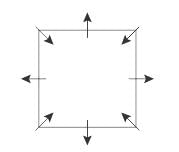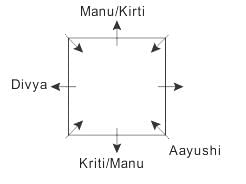Uttarakhand D.El.Ed Mock Test - 9 - UTET MCQ
30 Questions MCQ Test - Uttarakhand D.El.Ed Mock Test - 9
The Vardhana Dynasty ruled over which kingdom in ancient India?
Who among the following introduced the Doctrine of Lapse?
Who was the leader of the Indian National Congress during the Indian independence movement?
The theory of Plate Tectonics was first proposed by:
Which part of the Indian Constitution contains Directive Principles of State Policy?
Who has won the most Grand Slam singles titles in tennis as of September 2021?
Which of the following vitamins help in the absorption of calcium?
Directions:
In each of the following questions, there are four sentences or parts of sentences that form a paragraph. Identify the sentence(s) or part(s) of sentence(s) that is/are correct in terms of grammar and usage (including spelling, punctuation, and logical consistency). Then, choose the most appropriate option.
A. Chen Jianping repeated again on twitter something her fiance said
B. about anti-Japan protests getting violent, and added, "Charge, angry youth!"
C. For this, she was sentenced one year in a labor camp.
D. Twitter is banned in China, but its easy to use blocked sites with simple internet tricks.
Read the each sentence to find out whether there is any grammatical error in it. The error, if any will be in one part of the sentence. The letter of that part is the answer. If there is no error, the answer is 'D'. (Ignore the errors of punctuation, if any).
What significant feature characterizes Dehradun's Clock Tower?
What recent legal challenge is the All India Muslim Personal Law Board planning to undertake?
Statement 1: The Uniform Civil Code (UCC) in Uttarakhand allows for the registration of live-in relationships similar to marriages.
Statement 2: Under the UCC, individuals in a live-in relationship under the age of 18 are permitted to register their relationship.
Which of the answer figures is exactly the mirror image of the given figure when the mirror is held at MN?

Mirror is placed on the line MN, then which of the answer figures is the right mirror image?

Hemant started from his house and walked 3km eastward, then he turned right and walked 2km, then again he turned left and walked 1 km, then turned right and walked 2 km. He turned right again and walked 1 km and reached his school. What is the minimum distance between Hemant’s house and his school?
Direction: Study the following information carefully and answer the given questions besides.
Eight students Kirti, Ayushi, Manu, Sona, Aarti, Bobby, Ankita and Divya are sitting around the square table. Four students sit on each side while rest on each corner. Students at the side faces away from the centre and students at the corner faces toward the centre.
Divya sits third to the left of Ayushi. Sona sits immediate left of Ankita, who sits on the side of the table. Kirti sits opposite to Manu and both faces away from the centre. Neither Kirti nor Manu are beside Ayushi. Bobby is not an immediate right of Ayushi. Bobby is not adjacent to Manu.
Q. ____ sits third to the right of Kirti.
Directions to Solve
In each of the following questions there are three statements. Which are followed by three or four conclusions. Choose the conclusions which logically follow from the given statements.
Question -
Statements:
- All the locks are keys.
- All the keys are bats.
- Some watches are bats.
Conclusions:
- Some bats are locks.
- Some watches are keys.
- All the keys are locks.
Direction: Below are given letter A to Z. Under each capital letter a small letter is written which is to be used as a code for the capital letter:
In each of the following questions, a group of six capital letters is given and its code equivalent is given in one of the columns (1), (2), (3) and (4). Study the group of letters given in each question and with the help of code given above, choose the code equivalent from among (1), (2), (3) and (4) as your answer.
(A) julsqr, mkzbxn , hijmub, vishwa, ocdkzq, zocbak
(B) lzcndo, mzkbxn, ucjlbo, mkzbxn, amwrnd, hmfxco
(C) cxtndo, cvafog, amwnrd, hilmbu, vithwa, ocqzkd
(D) vithaw, mzkbnx, odcazq, napkin, amwrny, hijump

ELBJSR
In a certain code PATHOLOGIST is written as PIUBQKSRHFN. How is CONTROVERSY written in that code?
Directions: In this type of questions, some particular words are assigned certain substituted names. Then a question is asked that is to be answered in the substituted code language.
If 'sand' is called 'air', 'air' is called 'plateau', 'plateau' is called 'well', 'well' is called 'island' and 'island' is called 'sky', then from where will a woman draw water?
Direction: Read the following information carefully and answer the question that follow.
Six student A, B, C, D, E and F participate in a dancing competition wherein they won prizes 12000, 10000, 8000, 6000, 4000, 2000 according to the position secured. The following information is known to us
I. A won less money than B.
II. The difference between the winning of C and F was ₹ 2000
III. The difference between the winning of D and F was at least ₹ 4000
IV. E won the ₹ 8000 prize.
Q. Examine the following statements
I. Rama scored more than Rani.
II. Rani scored less than Ratna.
III. Ratna Scored more than Rama.
IV. Padma scored more than Rama but less than Ratna.
Who scored the highest?
Some boys are sitting in a line. Mahendra is on 17th place from left and Surendra is on 18th place from right. There are 8 boys in between them. How many boys are there in the line?
In this following questions, various terms of the letter series are given with one term missing as shown by (?). Choose the missing term out of the given alternative.
shg, rif, qje, pkd,?
In this following questions, various terms of the letter series are given with one term missing as shown by (?). Choose the missing term out of the given alternative.
Z, S, W, O, T, K, Q, G, ?, ?
There were two candidates in an election, 10% of voters did not vote and 48 votes were found invalid. The winning candidate got 53% of all the voters in the list and won by 304 votes. Find the total number of votes enrolled.
At Infosys, 60% of the employees are males and the rest are females. Further, 20% of the males and 15% of the females are getting bonus. If the number of employees getting bonus is 81, then find the total number of employees who are not getting bonus.
The manager of a circus decides to buy some animals for the show. He buys 10 giraffes costing as much as 24 dogs, 16 dogs costing as much as 4 oxen and 6 oxen costing as much as 4 elephants. If the cost of 10 elephants is Rs. 1,70,000, what is the cost of a giraffe?
































